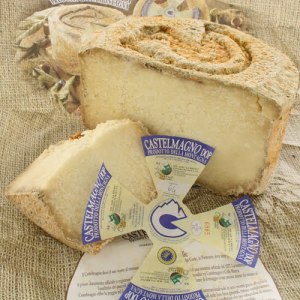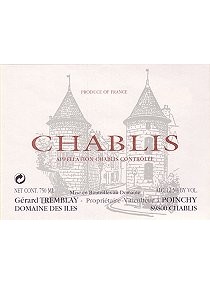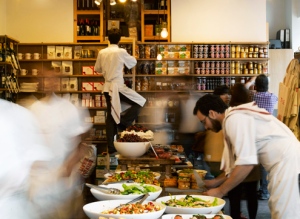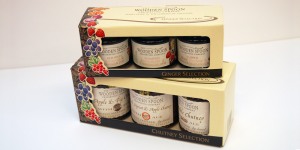If Mohammed Can’t Come to the Mountain … or how Capo Verde met Alto Adige (or how the karma of far-flung people and even further-flung places are tied with an invisible thread, with no beginning and end) …
Professor Matteo Pessina pf the Alma Wine Academy agreed to let us tag along on Saturday to his wine excursion to Alto Adige. Having little idea of what we were in for, and as we were on our way to the nearby Merano Wine Festival, in the general neck of the woods (or pre-Alpine region, as it were), there was no reason not to join the gang.
We met up at a petrol station about an hour north of Parma, with the Prof, his wife and various acquaintances equally keen to taste local boutique wines. The first town we stopped in had a well-stocked provisions shop, where we picked up assorted meats and cheeses for lunch, including a sort of gelatin pickled vegetable roll, which was a lot tastier and a lot less gelatinous than I would’ve imagined. Pretty darn tasty, I’d dare to say. In small quantities, of course. It makes sense then that I have never seen anyone wolfing down a gelatin pickled vegetable roll at any party lately …
We stopped off at a small, family winemaker’s cantina, and sat in the generous, autumn sunshine, among his vines, and up a street with a church that rings the bell every hour, with luscious Pink Lady apples dripping off the trees. We tasted a pas dose metodo classic sparkling wine, with no residual sugars and balanced yeasts, dry and fresh and perfect with the herbed goat cheese and dry, pita-like Alto Adesino bread we’d laid out for lunch.
The owner of this vineyard couldn’t have been a day over seventy, and he proceeded to explain to us in his thick Germanic twang (in this part of Italy, the locals of his generation speak Italian as a second language) that he was actually eighty-three. I was gob smacked, as my grandfather was always my example of delayed aging, or eternal youth, take your pick. But this man, he genuinely looked fifteen years younger than his birth certificate.
Usually farmers are known to be weathered by the sun, but here in the north with all the wholesome goodness around, Austrian-style if I have to make a comparison although this is most definitely still Italy. I suppose the crisp, fresh air purifies the skin and the soul alike.
After the subsequent bottles were bought, we made our way through the mountains to our next destination, a very small cantina, just four hectares, on the road to Castle Juval, near the Forst Beer factory. Here we were greeted by terraced, winding vines cultivated at six-hundred meters, onwards up to seven-hundred, with Riesling and Pinot Grigio taking advantage of the mineral-rich terrain.
Now here is where Capo Verde comes in, at six-hundred meters and counting. My wine school confidante Matthias started talking to the intern, David, and motioned me over, mentioning that the man spoke Portuguese. I bounced right up and started blabbering on in my Brazilian accent.
He spoke in a mixture of Portuguese and Italian, and gave us a brief introduction to Cape Verdean winemaking. Who knew? Most wine aficionados, I am sure. But, hey, you can only be new once, and I am a bit of a green tannin in the wine world, so the learning is long and the excitement palpable.
Here, then, is my version, in brief, of Cape Verdean viticultural history.
The chain of ten islands, located off the west coast of Africa, include nine which are habitable, and all derive, geologically speaking, from volcanic origins. Hence, on the island Ilha Fogo to be exact (Fire Island in English) there are mountains that rise up to two-thousand meters. David, the kind-hearted and gregarious intern who invited us to stay and help out in the cantina, clued us into his terroir.
Wine was introduced by the Portuguese to Cape Verde in the seventeenth century. It didn’t take long for it to catch on, and by the nineteenth century, from Guinea to Brazil, they were filling glasses with mineral-rich, lip-smackingly fresh reds, whites and passito from Capo Verde.
Principally, Cape Verdean winemakers cultivate the red varietal Preta Tradicional and the white Moscatel Branca, equivalent to Tourigia Nacional and Moscatel de Setubal, respectively, both from Portugal, original colonizers of the island chain.
The region called Cha-das-Caldeiras has been making wine for nearly a century, and in 1998 it got an injection of technical and financial assistance from an Italian agricultural cooperative, which kick-started a call to higher quality and quantity. When the project started in 1998, 120 hectares were utilized to grow the grapes. Today, the area has nearly doubled.
Most of the vines can be found on the volcano’s ridges and in the higher areas of Achada Grande. The dry, hot climate, with big temperature shifts between day and night and between the warm and cool seasons affect the wine greatly, and for the greater good. With many hours of sun during the vegetative cycle of the plant, accompanied by a super fertile, volcanic soil; create ideal conditions for a quality crop with considerable sugar content.
I could go on, but there is certainly a goldmine of information about Cape Verdean wines online, and I just wanted to share this peculiar and beautiful encounter up in the mountains of northern Italy with someone from an equally high place down in Africa, on a volcanic island chain.
There is something quite poetic and romantic about the contrast, and how wine brings the world together on a sunny hillside in November. It reminds me of finding seashells up in the mountains in Greece, and finding this incongruous, and being told that the slope I was standing on used to be filled with. Everything comes back round again. It’s like Matthias said, in life you always see people twice. I suppose the earth moves like its inhabitants, in this cycle of existence.
There’s got to be something about wine, volcanoes and karmic connections; it must be all the good energy coming up from the earth, out of the molten, into the roots, through the grapes and into the glass, reverberating through the laughter and good cheer of the company who share its libatious bounty.










